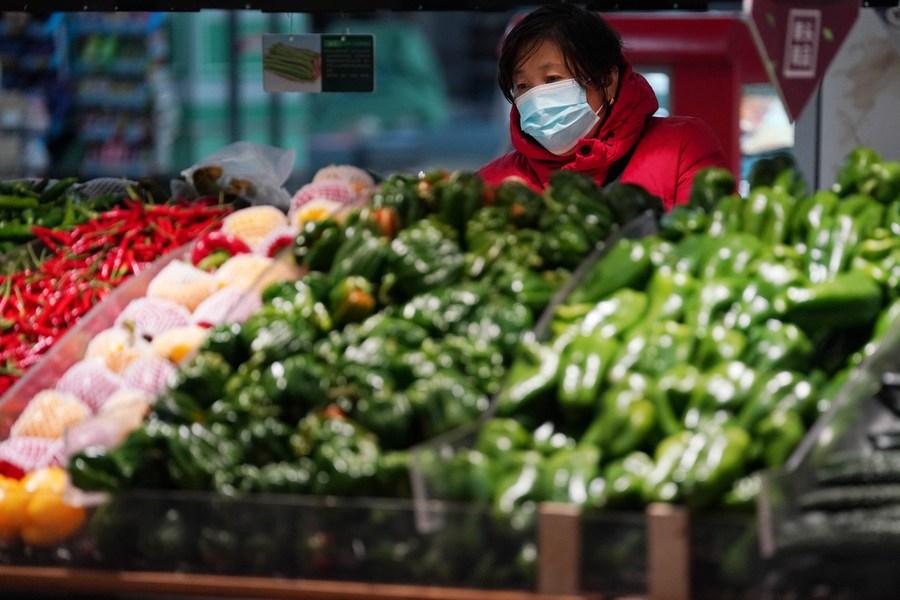
A citizen buys vegetables at a supermarket in Harbin, northeast China's Heilongjiang Province, Nov. 10, 2021. (Xinhua/Wang Jianwei)
BEIJING, Dec. 9 (Xinhua) -- China's consumer inflation rose further in November on warming demand, while factory-gate prices eased amid strengthened efforts to ensure supply, official data showed Thursday.
The country's consumer price index (CPI), a main gauge of inflation, rose 2.3 percent year on year in November, data from the National Bureau of Statistics (NBS) showed.
The figure was higher than the 1.5 percent year-on-year growth recorded in October, in part a result of the low base in the same period last year, said the NBS.
Specifically, food prices rebounded to climb 1.6 percent, as the price of pork, a staple meat in China, saw contraction narrow to 32.7 percent, said senior NBS statistician Dong Lijuan.
On a monthly basis, the CPI increased 0.4 percent, lower than the figure registered in October. Pork prices rebounded to jump 12.2 percent amid the seasonal demand surge, while the growth of fresh vegetable prices sank 9.8 percentage points to 6.8 percent due to government efforts to replenish the supply, said Dong.
"Rising production and logistics costs of farm produce due to freezing weather conditions, coupled with growing demand in preparation for the upcoming holidays, helped push up prices for vegetables, fruits and pork," said Guo Liyan, a researcher with the Chinese Academy of Macroeconomic Research.
Analysts say that prices of both vegetables and pork are unlikely to keep rising for extended periods because of sufficient supply.
Non-food prices rose 2.5 percent from a year earlier, largely unchanged from October, which analysts say reflected the impact of sporadic COVID-19 outbreaks.
China has set its consumer inflation target at approximately 3 percent for the year 2021, according to this year's government work report.
On the industrial side, China's factory gate prices saw a slower expansion in November due to greater efforts to implement policies to ensure supply and stabilize prices of energy and raw materials.
The producer price index (PPI), which measures costs for goods at the factory gate, went up 12.9 percent year on year in November.
The figure shrunk from the 13.5 percent year-on-year increase registered in October.
Specifically, the growth momentum in prices of production materials was slowing down last month, as the year-on-year growth rate dipped 0.9 percentage points from October to 17 percent, said senior NBS statistician Dong Lijuan.
Measures adopted by multiple departments to contain coal prices helped propel both the coal output and market supply to further grow, Dong said, adding that prices for coal mining and washing industry reversed the upward trend with a 4.9 percent month-on-month decline in November.
Against the backdrop of high prices of international crude oil and natural gas, the domestic oil-related industries saw rising prices with the PPI for the oil exploitation sector up 7.1 percent from a month ago, Dong said, adding that among the 40 surveyed industrial sectors, 37 reported year-on-year price rises.
Despite the factory prices contraction in November, analysts say that rising commodities prices could continue to trickle down to consumer products. More efforts are thus needed to monitor commodities prices and support medium, small and micro firms in the downstream supply chain.
While concerns grew over the possible spillover of recent global inflation to China, analysts expect China's consumer inflation to remain stable and factory prices to withdraw.
"With the help of macroeconomic policies focusing on cross-cyclical adjustment, the foundation for stable prices will be consolidated and price targets will be met," said Guo.




 A single purchase
A single purchase









